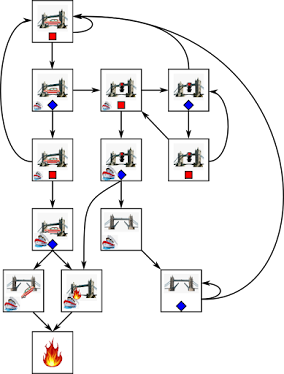On fiction: some idle napkin calculation
In preparation for writing yet another piece of fan-fiction, I browsed a bit of the AvP wiki. I'm ... impressed? amused? ... that the article on the Nostromo actually has numbers attached to the engine performance. The article on the Sulaco is a bit more skimpy on such data (and it appears to confuse acceleration for velocity).
I love hard sci-fi, and an attempt to make a space-faring future plausible is, I believe, an interesting source of stories. Sometimes though, I wonder whether it's not just better to leave the whole thing numberless. You want truckers in space, fine, postulate some magic that makes getting into space cheap. As long as you follow the implications of the magic, you'll be fine. No need to restrict yourself to tech that, maybe, could actually be built. Or else, you'll likely get in trouble.
Let's look at the Nostromo specs, as seen at the AvP wiki. Power plant has 2.8TW (fairly impressive), and some kind of Tachyonic engines that allow it to cruise at 153 times the speed of light. Suitably magical, suitably fine.
Then we find that, for orbital and subluminal velocity maneuvers, the Nostromo uses a pair of engines, each providing 65830 metric tons of thrust, using water as reaction mass. There appears to be some confusion when it's later claimed "when running wide-open, both of the engines give a high impulse thrust totaling of 131,660 kN". It would appear that the latter figure is the total thrust available from the engines (and 65830 times 2 is 131660, incidentally), but one kN is nowhere near one metric ton "of force/thrust". Measuring force by weight is an intuitive way, and roughly ten Newtons is the weight of one kilogram on Earth. Using this naturally implied convention, one metric ton of thrust is the same as 10kN. So maybe there's a zero missing in the total. Whatever, no big deal.
But let's look deeper a bit. How much power does the exhaust from one of those motors contain? Lacking any other data, I'd say a decent guess is, about the same as (half of) the fusion power plant output. I'm not seeing where the Nostromo would need 2.8TW except for propulsion, so there's no reason why it would contain such a massive power plant AND a bigger one on each engine.
There's the other complication that not all the power used by an engine will end up in the exhaust, and thus be used for thrust. But whatever, let's be optimistic. All the power going in the engine is taken into the exhaust and converted to thrust.
Power is force times velocity. In case of the exhaust, that is to say, thrust times the exhaust velocity (the speed at which the reaction mass is thrown out). Let's then say that one engine, with 1.4TW of power, provides 658300 kN of thrust. Which gives an exhaust velocity of about 2127 m/s.
From now on this exhaust velocity is what matters, and the result would have been the same if I had used the full power output of the plant (2.8TW) for the thrust provided by the engines, combined.
It may sound like quite a firehose that, which chucks water out at 2km/s. This velocity however is tiny, as far as space propulsion goes. It's smaller than the exhaust velocities for current chemical rocket engines (about 4.3km/s for some stage-1 engines like LE-7A, HM-60 and J-2). The reason it's so inadequate can be seen from the rocket equation, which tells one how much a delta-V can a rocket or ship achieve, given the velocity of the engine exhaust and the mass ratio (the ratio of full mass vs. dry- no propellant- mass).
The equation says, delta-V equals exhaust velocity times the natural logarithm of (initial mass with propellant / final mass).
Say the Nostromo needs to get in orbit from Earth, which needs an 8km/s delta-V. So roughly speaking, this requires that the Nostromo have a mass ratio of 54. For every kilogram of payload AND ship, there need to be 53 kilograms of propellant.
Ok, not fair. The Nostromo maybe wasn't made to take off from Earth. But maybe it was made for maneuvers inside a solar system. Using a 5km/s quick-and-dirty approximation as the delta-V needed for a Hochmann (and very slow) transfer orbit from Earth to Mars, we find that the Nostromo needs about 9.5 kilograms of propellant for every kilogram of cargo and ship. In particular, if it wanted to haul around 20 million tons of rocks, it needs to also lug around about 200 million tons of water as reaction mass.
That should tell one that things don't look too good, economically speaking. They certainly don't look so good from a technical standpoint. Where are those 200 million tons of water stored? The AvP wiki doesn't mention any such thing, indeed there's no indication that the Nostromo is, basically, a giant tub with a tiny cargo area. It's intended to be a somewhat tiny trailer ship, lugging lots of cargo- not propellant- around.
The mass of the Nostromo is given as 60000 metric tons, max. As a side note, let's say all those 60000 metric tons are propellant, and let's say the ship itself is completely massless, and has a cargo of 20 million metric tons. Mass ratio is 1.003, the natural logarithm is about 0.003. Meaning, the delta-V that can be achieved with an exhaust velocity of 2.127km/s is a mere 6m/s. Meanwhile, the delta-V of a freaking extra-vehicular activity unit (NASA's Manned Maneuvering Unit) is 24m/s.
So even for basic docking maneuvers, I'd guess those powerful engines aren't really worth anything.
Yeah ... sometimes not putting numbers on things is the best idea.
I love hard sci-fi, and an attempt to make a space-faring future plausible is, I believe, an interesting source of stories. Sometimes though, I wonder whether it's not just better to leave the whole thing numberless. You want truckers in space, fine, postulate some magic that makes getting into space cheap. As long as you follow the implications of the magic, you'll be fine. No need to restrict yourself to tech that, maybe, could actually be built. Or else, you'll likely get in trouble.
Let's look at the Nostromo specs, as seen at the AvP wiki. Power plant has 2.8TW (fairly impressive), and some kind of Tachyonic engines that allow it to cruise at 153 times the speed of light. Suitably magical, suitably fine.
Then we find that, for orbital and subluminal velocity maneuvers, the Nostromo uses a pair of engines, each providing 65830 metric tons of thrust, using water as reaction mass. There appears to be some confusion when it's later claimed "when running wide-open, both of the engines give a high impulse thrust totaling of 131,660 kN". It would appear that the latter figure is the total thrust available from the engines (and 65830 times 2 is 131660, incidentally), but one kN is nowhere near one metric ton "of force/thrust". Measuring force by weight is an intuitive way, and roughly ten Newtons is the weight of one kilogram on Earth. Using this naturally implied convention, one metric ton of thrust is the same as 10kN. So maybe there's a zero missing in the total. Whatever, no big deal.
But let's look deeper a bit. How much power does the exhaust from one of those motors contain? Lacking any other data, I'd say a decent guess is, about the same as (half of) the fusion power plant output. I'm not seeing where the Nostromo would need 2.8TW except for propulsion, so there's no reason why it would contain such a massive power plant AND a bigger one on each engine.
There's the other complication that not all the power used by an engine will end up in the exhaust, and thus be used for thrust. But whatever, let's be optimistic. All the power going in the engine is taken into the exhaust and converted to thrust.
Power is force times velocity. In case of the exhaust, that is to say, thrust times the exhaust velocity (the speed at which the reaction mass is thrown out). Let's then say that one engine, with 1.4TW of power, provides 658300 kN of thrust. Which gives an exhaust velocity of about 2127 m/s.
From now on this exhaust velocity is what matters, and the result would have been the same if I had used the full power output of the plant (2.8TW) for the thrust provided by the engines, combined.
It may sound like quite a firehose that, which chucks water out at 2km/s. This velocity however is tiny, as far as space propulsion goes. It's smaller than the exhaust velocities for current chemical rocket engines (about 4.3km/s for some stage-1 engines like LE-7A, HM-60 and J-2). The reason it's so inadequate can be seen from the rocket equation, which tells one how much a delta-V can a rocket or ship achieve, given the velocity of the engine exhaust and the mass ratio (the ratio of full mass vs. dry- no propellant- mass).
The equation says, delta-V equals exhaust velocity times the natural logarithm of (initial mass with propellant / final mass).
Say the Nostromo needs to get in orbit from Earth, which needs an 8km/s delta-V. So roughly speaking, this requires that the Nostromo have a mass ratio of 54. For every kilogram of payload AND ship, there need to be 53 kilograms of propellant.
Ok, not fair. The Nostromo maybe wasn't made to take off from Earth. But maybe it was made for maneuvers inside a solar system. Using a 5km/s quick-and-dirty approximation as the delta-V needed for a Hochmann (and very slow) transfer orbit from Earth to Mars, we find that the Nostromo needs about 9.5 kilograms of propellant for every kilogram of cargo and ship. In particular, if it wanted to haul around 20 million tons of rocks, it needs to also lug around about 200 million tons of water as reaction mass.
That should tell one that things don't look too good, economically speaking. They certainly don't look so good from a technical standpoint. Where are those 200 million tons of water stored? The AvP wiki doesn't mention any such thing, indeed there's no indication that the Nostromo is, basically, a giant tub with a tiny cargo area. It's intended to be a somewhat tiny trailer ship, lugging lots of cargo- not propellant- around.
The mass of the Nostromo is given as 60000 metric tons, max. As a side note, let's say all those 60000 metric tons are propellant, and let's say the ship itself is completely massless, and has a cargo of 20 million metric tons. Mass ratio is 1.003, the natural logarithm is about 0.003. Meaning, the delta-V that can be achieved with an exhaust velocity of 2.127km/s is a mere 6m/s. Meanwhile, the delta-V of a freaking extra-vehicular activity unit (NASA's Manned Maneuvering Unit) is 24m/s.
So even for basic docking maneuvers, I'd guess those powerful engines aren't really worth anything.
Yeah ... sometimes not putting numbers on things is the best idea.


Comments
Post a Comment